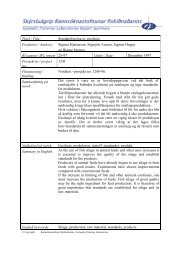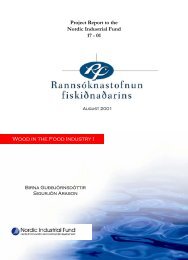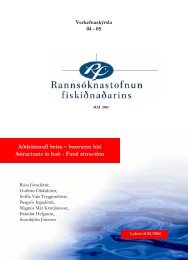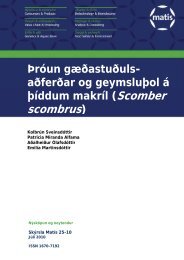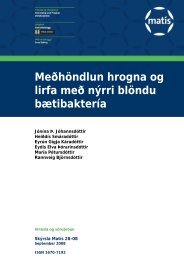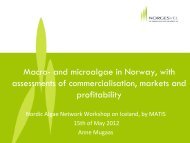Microbiology and Spoilage Trail in Nile Perch (Lates niloticus), Lake ...
Microbiology and Spoilage Trail in Nile Perch (Lates niloticus), Lake ...
Microbiology and Spoilage Trail in Nile Perch (Lates niloticus), Lake ...
You also want an ePaper? Increase the reach of your titles
YUMPU automatically turns print PDFs into web optimized ePapers that Google loves.
5.4 PRESUMPTIVE SSO<br />
There are two types of colonies-counts which are reported from growth on Iron Agar (IA),<br />
SSO H2S producers (black colonies) that may <strong>in</strong>clude bacteria like Shewanella putrefaciens<br />
<strong>and</strong> Vibrionaceae/ Aeromonas <strong>and</strong> the SSO non H2S producers (white colonies) that<br />
<strong>in</strong>clude Pseudomonas spp as well as Enterobacteriaceae spp (figure 34). These SSOs were<br />
identified by Gram et al., (1989) <strong>in</strong> whole <strong>Nile</strong> perch <strong>and</strong> fillets stored at 0 o C. Similar<br />
studies by Chytiri et al., (2004) <strong>in</strong> ra<strong>in</strong>bow trout; Fonnesbech et al., (2005) <strong>and</strong> Hozbor et<br />
al., (2006) <strong>in</strong> sea salmon all identified similar SSOs as Gram-negative, rod shaped, oxidase<br />
positive <strong>and</strong> glucose fermentative/non fermentative <strong>and</strong> or H2S producers <strong>and</strong> non H2S<br />
producers <strong>in</strong> IA.<br />
68




